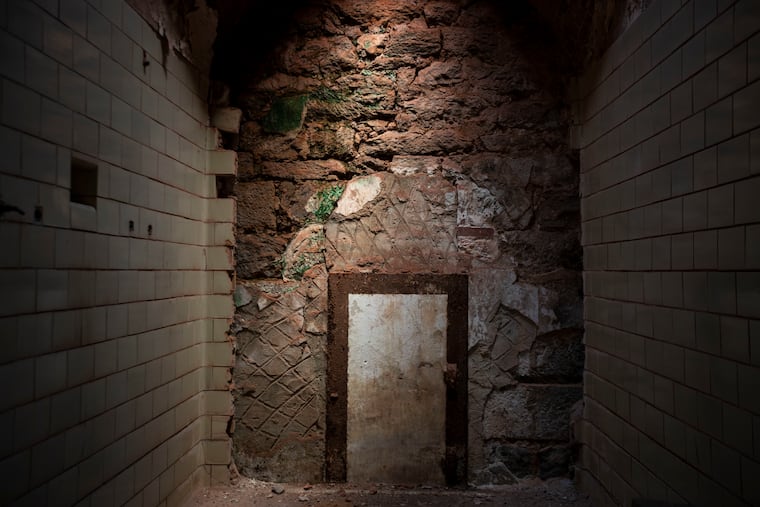The majority of people in solitary are Black. Philly forefathers designed it that way.
Three takeaways from A More Perfect Union’s latest report.

American democracy began in Philadelphia, and so did American incarceration. In 1790, the nation’s first penitentiary opened on Walnut Street, introducing America’s first solitary confinement cells and birthing a system that would transform the world’s conception of criminal justice and change millions of lives.
The use of incarceration as punishment, rather than merely a means of pre-trial detention, was born out of Quaker ideals — proposed as an alternative “to public humiliations and corporal punishment,” Samantha Melamed writes in “Inventing Solitary,” published Wednesday as the latest installment of The Inquirer’s More Perfect Union series. Prominent Philadelphians claimed that isolation, in particular, would create an environment conducive to repentance.
Examining the Philadelphia roots of a prison system that today incarcerates more people than any other in the world, Melamed reports on the racism that defined it from its founding more than 230 years ago.
Here are three takeaways from A More Perfect Union’s latest installment, “Inventing Solitary.”
American solitary confinement started in Philadelphia
While Philadelphia is home to many firsts, solitary confinement’s start here is an “overlooked” one.
The first dedicated solitary cells in the U.S. were found within the former Walnut Street Prison, which was also the first state penitentiary. When it opened in 1790, it was the largest and most expensive prison ever built in the Commonwealth, a title later held by Eastern State Penitentiary – which opened in 1829 as the first institution designed to hold all prisoners in total isolation, a regime called “the Pennsylvania system.”
Prison administrators and politicians around the country quickly recognized the troubling effects of long-term isolation, long before Eastern State abandoned the practice. But solitary confinement remains in use as a disciplinary tool in prisons and jails across the country. Out of the more than one million people incarcerated in U.S. state prisons today, 55,000 or more are kept in restricted housing units, spending at least 22 hours a day in their cells.
Mental health impacts of solitary confinement
Numerous scientific studies have documented negative impacts of solitary confinement on the human brain and body. Research shows connections to paranoia, psychosis, post-traumatic stress disorder, emotional disturbances, sleep disruptions, cognitive decline, and “isolation panic,” that continue to fester after a person is released.
The impacts were something Charles Dickens observed upon visiting Eastern State Penitentiary in 1842.
“I hold this slow and daily tampering with the mysteries of the brain to be immeasurably worse than any torture of the body,” he said.
The first-hand accounts described in the story seem to confirm Dickens’ remarks made nearly two centuries ago. Caine Pelzer, 43, who was placed in a 10-foot-by-8-foot solitary cell for more than a decade, called the experience “torture of the mind.”
“It’s a zoo of humans,” he said. “Even animals could see where the sun or moon is at; our windows are covered.”
Other impacts detailed in the story include depression, anxiety, hearing voices, and suicidal thoughts.
“I don’t think you can be more isolated without being in a coffin,” said Ab’dallah Lateef, co-executive director of the Campaign for the Fair Sentencing of Youth, of his experience.
Racial disparities in Philadelphia’s prison population
Walnut Street Prison’s population was disproportionately Black since it opened in 1790 — just a decade after 1780 Abolition Act, which provided for the gradual abolition of slavery in Pennsylvania.
“This was very much a system designed for controlling Black people, and people who were fighting for freedom,” said historian Jen Manion, author of Liberty’s Prisoners: Carceral Culture in Early America.
Those disparities continued at Eastern State Penitentiary, and grew even more pronounced in the era of mass incarceration that began in 1970. In Philadelphia, the city jails jumped from a 50% Black population to 95% between 1970 and 1974 alone.
Today, Black people are still imprisoned at a higher rate than whites. In Philadelphia jails, Black people are detained at a rate nine times higher than white residents, according to Melamed’s reporting.
Black people are placed into solitary confinement at a higher rate than whites, too, making up 58% of those in Restricted Housing Units in Pennsylvania, but just 11% of the state’s overall population.
“This disproportionality, this harsher sentencing, this projection of violence, all of that was there from the beginning,” Kali Nicole Gross, an Emory University historian and author of Colored Amazons: Crime, Violence and Black Women in the City of Brotherly Love, 1880-1910, said in the story. “It made me question: If these biases are so deeply embedded in our nation’s founding, what chance do we have to change that today?”